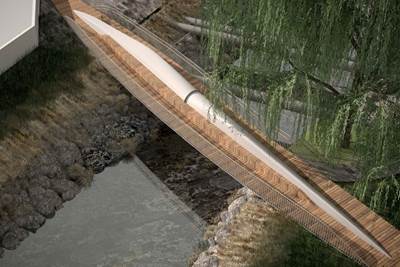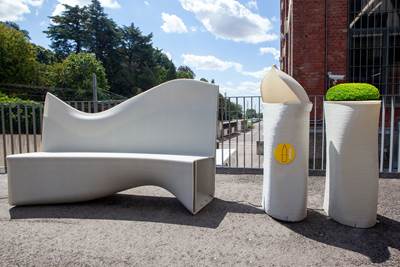Repurposing wind blades as functional community art pieces
Ohio-based Canvus Inc. upcycles fiberglass wind blades, car tires and post-consumer plastics to create outdoor furniture that amplifies sustainability messages in community spaces.
Share
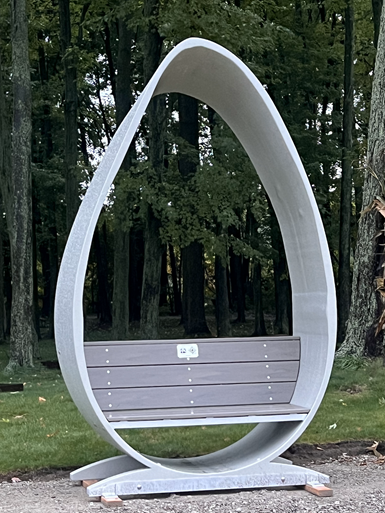
Founded in 2021, Canvus Inc. works to repurpose decommissioned, fiberglass composite wind blades and other materials into functional, creative outdoor furniture that can be donated to communities. Photo Credit, all images: Canvus Inc.
What to do with fiberglass composite wind blades at their end of life (EOL) is a challenge many are working on across the supply chain. Canvus Inc. (Rocky River, Ohio, U.S.) is one company turning wind blades and other upcycled materials into creative and functional, community-centered outdoor furniture products.
Parker Kowalski, Canvus’ managing director of brand, explains that the company’s leaders came from a variety of industries, including a background in wind blade dismantling services for retired wind blades that are decommissioned at their EOL or through repowering projects, as well as fiberglass recycling via cement kiln co-processing. In 2021, the company Canvus was formed with a focus on repurposing or upcycling wind blades. “We wanted to preserve the qualities and durability of the wind blade structures rather than break them down via cement kiln co-processing or pyrolysis,” Kowalski says.
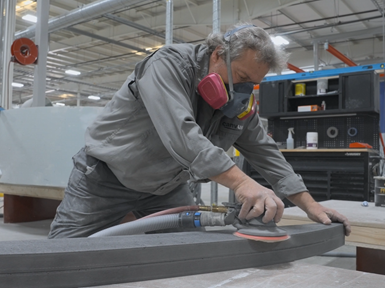
Canvus uses 3D scanning to relay information about the EOL wind blades’ mechanical properties, which informs the design process. Sanding (top photo), repair and assembly (below) are performed by technicians at the company’s Ohio facility.
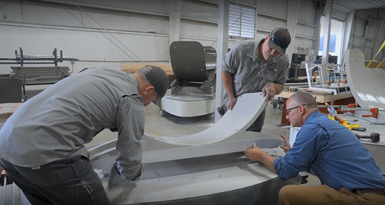
Today, Canvus partners with wind farms to collect decommissioned blades. In the field, these are cut by Canvus or a field services company into 50-foot sections for transport to the company’s 110,000-square-foot manufacturing facility in Avon, Ohio, where they are cut further into smaller pieces — called filets — sized for specific products. Each filet is then scanned to create a 3D model of the blade, which helps inform the design process for new products. Next, the filets are moved to a fiberglass fabrication area, where any damage to the fiberglass composite skins is repaired. “We sand the product, perform bodywork and reseal the edges,” Kowalski says.
The repaired pieces are then combined with other upcycled materials — such as lumber made from post-consumer plastics, and rubber from vehicle tires and shoes — and constructed into one of Canvus’ nine products. These products, which include several styles of outdoor benches and tables, are known by names like Deborah, Gus and Belle. Kowalski explains, “We gave these products human names because they all have their own unique identity. These products are designed for large outdoor public spaces and we wanted people to connect with them.”

Alongside its standard finishes, Canvus also works with local and national artists to create custom pieces.
Each product takes about 7 days total from start to finish, including time for curing and paint drying. Canvus has between 300 and 500 products in circulation at any given time. Most of Canvus’ products are finished in one of two standard colors, but the company also works with local and national artists who paint one-off pieces suited for specific communities and projects, as part of the PAR (primed and ready) program.
Why outdoor furniture? “Originally when we started Canvus, we explored bridges, playgrounds and bus stops, but there are only so many bridges that need to be built in the U.S. or across the world, and there are only so many playgrounds that need to be built. Our products are designed to be made at scale. So we focused on nine essential products that are needed across communities, parks and schools,” Kowalski says. “Our mission as a company is to create an ecosystem for all to amplify public spaces.”
Products can be purchased directly through Canvus’ website, or donated to communities through the company’s Request Program.
Each product is finalized with a QR plaque that leads to a webpage highlighting the donor and explaining Canvus’ story and how this piece of furniture was built.
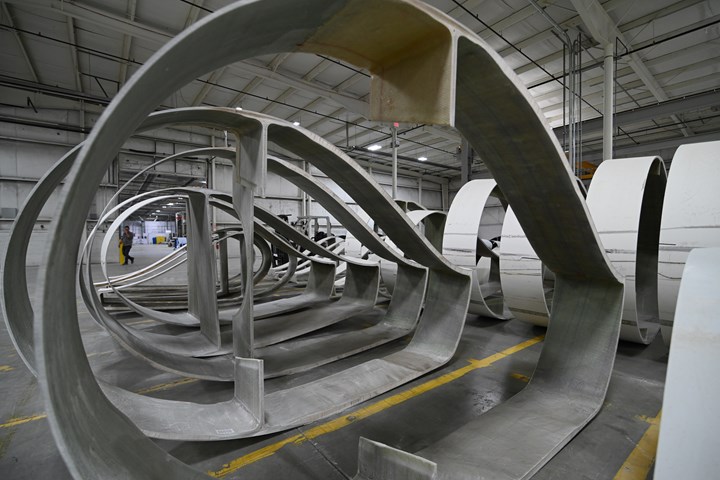
While supporting fiber reclamation and fully recyclable wind blades for future use, Canvus’ focus is to provide a solution for today’s non-recyclable blades which will be decommissioned in the coming decades.
The company began shipping products in August 2023. As of late January 2024, thousands of pieces have been purchased or donated to communities around the U.S., and more than 600 communities have signed up for Canvus’ Request program.
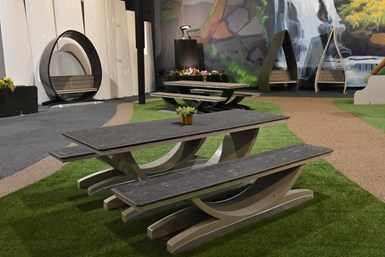
Currently, the company offers a suite of nine outdoor furniture products including tables and benches.
Alongside these efforts, Canvus also works with and supports other wind blade recycling technologies in development. “Thousands of wind turbines come down every year, and that number is only going up,” Kowalski notes. “At the same time, hundreds of millions of tires go offline each year, and even more plastic waste. We are confident about the supply and that our products will be a solution for decades to come. At the same time, we’re in support of other solutions like pyrolysis and co-processing. We know fully recyclable wind blades are coming. But for the next 15 years and for the 210,000 non-recyclable blades in operation today, Canvus is a fantastic solution.”
Related Content
Composites end markets: Electronics (2024)
Increasingly, prototype and production-ready smart devices featuring thermoplastic composite cases and other components provide lightweight, optimized sustainable alternatives to metal.
Read MoreBabyark launches smart, composites-intensive car seat
Impact-absorbing car seat approaches safety holistically with carbon fiber and D3O materials and embedded sensors for real-time monitoring.
Read MoreWe Are One announces new Convergence carbon fiber rims, wheels
Boston Materials ZRT composite films are featured in the twisted-shape bicycle rim, enhancing strength, durability and light weight.
Read MoreLighter, stronger, faster bionic hand aided by composites design
Psyonic’s touch-sensing prosthetic hand leverages bionic technology, 3D printing and a carbon fiber composite exterior for light weight, high strength and high-tech functionality.
Read MoreRead Next
Recycling end-of-life composite parts: New methods, markets
From infrastructure solutions to consumer products, Polish recycler Anmet and Netherlands-based researchers are developing new methods for repurposing wind turbine blades and other composite parts.
Read MoreUrban furniture project demonstrates green potential for composite 3D printing and recycled materials
Large-format AM specialist Caracol and partners designed custom, 3D-printed outdoor furniture with glass fiber-reinforced recycled polypropylene, and conducted an LCA to evaluate and improve the process.
Read MoreMoving toward next-generation wind blade recycling
Suppliers, fabricators and OEMs across the composite wind blade supply chain ramp up existing technologies, develop better reclamation methods and design more recyclable wind blades.
Read More.jpg;width=70;height=70;mode=crop)
.jpg)




